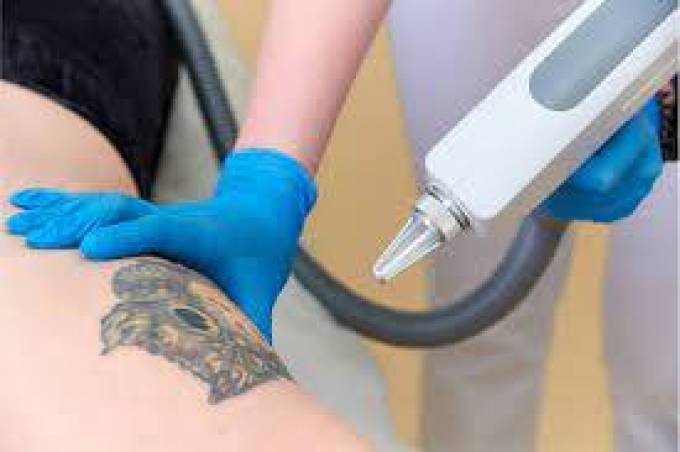Laser Tattoo Removal: Your Ultimate Guide
Published By Bisma Jamal, 6 Sep 2024

If you’ve decided to remove an unwanted tattoo, Laser Tattoo Removal in Dubai is one of the most effective and advanced methods available. This guide will walk you through everything you need to know about laser tattoo removal, from how it works to what you can expect during and after the process.
How Laser Tattoo Removal Works
Laser tattoo removal uses high-intensity light beams to break down the ink particles embedded in the skin. The laser targets specific wavelengths of light, which are absorbed by the ink and cause it to fragment into smaller particles. These smaller particles are then gradually absorbed and eliminated by the body’s natural processes.
Types of Lasers Used
There are several types of lasers used in tattoo removal, each designed to target different ink colors and depths:
- Q-Switched Lasers: These are the most common and use short bursts of high-energy light to break down ink. They are effective for a wide range of colors.
- Nd
Lasers: These lasers are especially good for darker inks, like black and blue, and can penetrate deeper into the skin. - PicoSure and PicoWay Lasers: These are newer technologies that use picosecond pulses to target ink more precisely and reduce treatment time.
Preparation for Laser Tattoo Removal
-
Consultation: Start with a consultation from a qualified specialist. They will assess your tattoo, skin type, and overall health to develop a customized treatment plan.
-
Pre-Treatment Care: Follow any pre-treatment instructions provided, which may include avoiding sun exposure and certain medications. Proper preparation helps in achieving better results and reduces potential risks.
-
Patch Test: Some clinics may perform a patch test to determine how your skin reacts to the laser. This can help in adjusting the laser settings for your specific needs.
What to Expect During the Procedure
-
Sensation: During the procedure, you may experience a sensation similar to a rubber band snapping against the skin. Most people find this discomfort manageable, and topical anesthetics can be used to minimize pain.
-
Treatment Time: The duration of each session varies depending on the size and complexity of the tattoo. Small tattoos may take just a few minutes, while larger ones can take up to an hour.
-
Number of Sessions: Multiple sessions are usually required to achieve desired results. The number of sessions needed depends on factors like the tattoo’s color, size, and depth.
Aftercare Tips
-
Keep It Clean: Follow your specialist’s aftercare instructions, which typically include keeping the treated area clean and dry. Avoid scrubbing or picking at the area.
-
Apply Healing Ointment: Use any prescribed ointments or creams to aid healing and prevent infection. These can help soothe the skin and promote recovery.
-
Avoid Sun Exposure: Protect the treated area from sun exposure by wearing sunscreen with a high SPF and avoiding direct sunlight. UV rays can cause pigmentation changes and affect the healing process.
-
Monitor Healing: Watch for signs of unusual reactions, such as excessive redness, swelling, or blistering. If you notice any concerning symptoms, contact your specialist for advice.
-
Follow Up: Attend all scheduled follow-up appointments to monitor progress and determine if additional treatments are needed.
Managing Expectations
-
Gradual Improvement: Laser tattoo removal is a gradual process. It may take several sessions to achieve significant lightening or complete removal of the tattoo. Patience is key.
-
Complete Removal: While many tattoos can be significantly lightened or removed, some may not be completely erased, especially those with certain colors or deep ink. The goal is often to achieve the best possible result rather than complete removal.
-
Skin Changes: Be prepared for some changes in skin appearance, such as temporary redness or pigmentation changes. These are usually temporary and resolve as the skin heals.
Potential Risks and Side Effects
-
Scarring: Although laser tattoo removal is generally safe, there is a small risk of scarring. Following aftercare instructions and choosing a skilled specialist can help minimize this risk.
-
Pigmentation Changes: Some people may experience changes in skin pigmentation, either lighter or darker, especially if proper sun protection is not maintained.
-
Infection: There is a risk of infection if the treated area is not kept clean. Proper aftercare reduces this risk.
Cost Considerations
Laser tattoo removal can be an investment, with costs varying based on factors like the size of the tattoo and the number of sessions required. Many clinics offer payment plans or financing options to help manage the cost.
Choosing the Right Specialist
-
Credentials: Ensure the specialist is certified and has experience with laser tattoo removal. Check their credentials and read reviews from other patients.
-
Technology: Verify that the clinic uses up-to-date laser technology and maintains high hygiene and safety standards.
-
Consultation: A thorough consultation is essential. The specialist should provide a clear explanation of the process, expected results, and any potential risks.
Conclusion
Laser tattoo removal offers an effective solution for those seeking to remove unwanted tattoos or make space for new designs. You can achieve the best possible results by understanding how the process works, preparing adequately, and following aftercare instructions. Remember that patience and realistic expectations are crucial, as the process can take time and may not always result in complete removal. With the right approach and professional guidance, laser tattoo removal can pave the way for clear, smooth skin and a fresh start.
